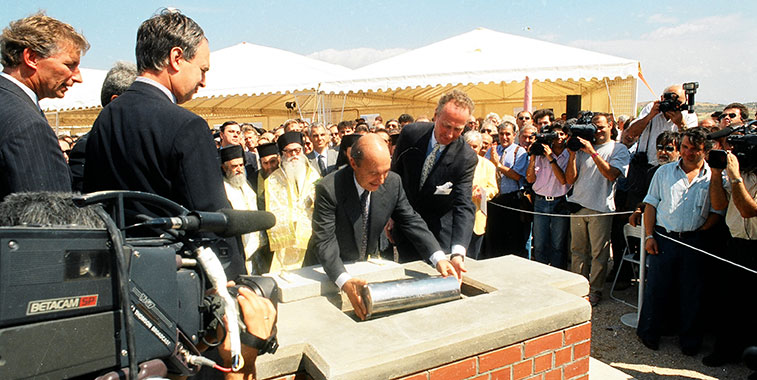By Robert O’Meara

At the groundbreaking ceremony for Athens International Airport, in September 1996. Pictured centre is Greek Prime Minister at the time, Costas Simitis, and to his right is the first AIA CEO, Dr Joerg Schill.
Behold, Athens – the last greenfield project to replace an existing major European airport, which began operations on 29 March 2001, over 15 years ago. The story of its construction and approach to airport operations provides lessons for many.
With the existing airport of the time overwhelmed by capacity issues, the project of a new airport for Athens had been on the cards for some time, but the failure of the government’s initial bid to host the centenary of the Olympic Games of 1996 gave everyone pause for thought. It was a shock that made them realise that the capital city of Greece needed better infrastructure, including a new airport (in 1998, when the project was already underway, Athens was subsequently selected to host the 2004 Olympics).
What followed was a surprising innovation. The new airport company, Athens International Airport, became a pioneer of international Public-Private Partnership (PPP), being the first major greenfield airport with the participation of the private sector. The cost for the development of the airport was financed mainly from bank loans – with European Investment Bank being the major lender, while the remaining funding was provided through private shareholders equity and grants. Today, ownership continues to be divided between the Hellenic Republic (Greek State) and Private Sector in a 55%-45% stake, although the private shareholders have changed.
Quite aside from its ownership structure, Athens is actually emblematic of the business transformation of Europe’s airports in many other ways too. Its traffic growth and mix of airline customers are impressive – and in the context of the ROUTES events, Athens International Airport is the most awarded airport with 16 distinctions over 12 years. It was also the first airport in Europe to invest in a photovoltaic park, supplying it with some of its power – part of the fabric of its efforts to lower its carbon footprint (at present, it is Airport Carbon Accredited for Level 3, Optimisation).
But let’s take a step back, to its status as the last major airport project to completely renew the first impression visitors get of a country. Before that, Munich Airport held the distinction, moving to an entirely new airport site in 1992, preceded by many other such grand projets at airports in the 2 decades before that. But little of note has happened since.
Meanwhile, the airports operators in UAE and Qatar have opened extraordinary new facilities and between 2000 and 2020, China will have built and opened over 75 new airports. You could be forgiven for asking “has Europe’s airport capacity mojo gone East?”
Airport capacity – only a problem when you don’t have it
Over the past 25 years, a visible trend has emerged about airport capacity in Europe – there is not enough of it and building more of it is becoming an increasingly arduous process.
EUROCONTROL and its highly regarded ‘Challenges of Growth’ reports on airport capacity – issued every 4 years – continue to issue warnings, even drilling down to identifying capacity issues at national level in many cases. But it has become increasingly clear that airport capacity only becomes a genuine priority when governments recognise its impact on their economies.
As this article goes to print, the Conservative Government in the UK is on the cusp of making the decision that has been deferred time and again, over 4 decades: where to build a new runway in the South East of England. It’s been a long and bumpy road to get here, but perhaps now that the UK has decided to exit the EU, people will at least agree that an island economy lives or dies by its air connectivity.
Willie Walsh, the CEO of International Airlines Group (IAG) has hedged his bets beyond Heathrow and Gatwick, operating aircraft out of Dublin (currently applying to build a new runway) and Barcelona and Madrid where capacity is not a problem, thanks to the foresight of the Spanish airport operator, Aena.
And the next big visionary project is already underway. Three years ago, a new greenfield airport project emerged in Europe – IGA’s new airport for Istanbul, due to open at the end of 2017, with an eventual capacity of 150 million passengers a year.







